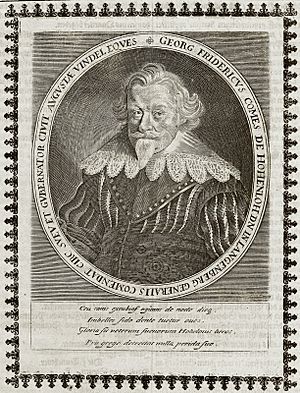Georg Friedrich of Hohenlohe-Neuenstein-Weikersheim facts for kids
Georg Friedrich von Hohenlohe-Neuenstein-Weikersheim (born September 5, 1569 – died July 7, 1645) was a German nobleman. He was a military officer and also a talented poet.
Contents
Early Life and Education
Georg Friedrich was born in Neuenstein, Germany. His father was Wolfgang, Count of Hohenlohe-Weikersheim, and his mother was Magdalena of Nassau-Dillenburg.
When he was 17 years old, in 1586, Georg Friedrich began his studies. He attended the University of Geneva until 1588. After that, he traveled to France and then to Italy to continue his education. In Italy, he studied at the universities of Siena and Padua.
Military Career and Leadership
After finishing his studies, Georg Friedrich became a soldier. In 1591, he fought alongside Henry IV of France against a group called the Catholic League. This was a religious and political conflict in France.
Later, in 1595, he fought in a war against the Ottoman Turks and was promoted to the rank of Colonel. In 1605, he helped put down an uprising in Hungary as an imperial field commander.
Joining the Bohemian Estates
On June 18, 1607, Georg Friedrich married Eva von Waldstein. This marriage connected him to an important group called the Bohemian Estates. This group was resisting the rule of King Ferdinand II, who later became the Holy Roman Emperor.
Georg Friedrich became a general commander for the Estates. He was in charge of organizing their forces. During the Battle of White Mountain, a major battle, he led a group of cavalry soldiers.
Facing Imperial Outlawry
In 1621, Emperor Ferdinand II declared Georg Friedrich and others to be traitors. This meant they were "outlaws" under imperial law. This is called an imperial ban.
Despite being outlawed, Georg Friedrich managed to make peace with the emperor. He was even allowed to keep control of his family's land in Weikersheim. He had inherited this land after his father passed away in 1610.
Later Life and Return to Peace
Georg Friedrich's first wife, Eva, died in 1631. He married again on August 17, 1633, to Maria Magdalena von Oettingen-Oettingen. However, she passed away less than three years later, in 1636.
Swedish Regent and Second Outlawry
In 1632, Georg Friedrich took on a new role. He became the Swedish regent for the Swabian Circle. A regent is someone who governs a country or region when the ruler is absent or too young.
Accepting this job made the emperor very angry, and Georg Friedrich was immediately outlawed again. The emperor also gave Georg Friedrich's land in Weikersheim to the Teutonic Order. The Hohenlohe family only got their land back after the Peace of Westphalia in 1648.
Retirement and Poetry
Because he was an outlaw, Georg Friedrich was not included in the Peace of Prague in 1635. However, in 1637, the emperor personally forgave him.
After this, Georg Friedrich moved to Langenburg and stayed away from politics. In Langenburg, he focused on his writing. He mainly wrote prayers and poems.
Count Georg Friedrich of Hohenlohe-Neuenstein-Weikersheim died in Langenburg on August 7, 1645. He was 76 years old.
Works
- Geistliche Psalmen und Kirchengesänge ("Spiritual Psalms and Church Songs", 1648)
See also
 In Spanish: Jorge Federico de Hohenlohe-Neuenstein-Weikersheim para niños
In Spanish: Jorge Federico de Hohenlohe-Neuenstein-Weikersheim para niños


